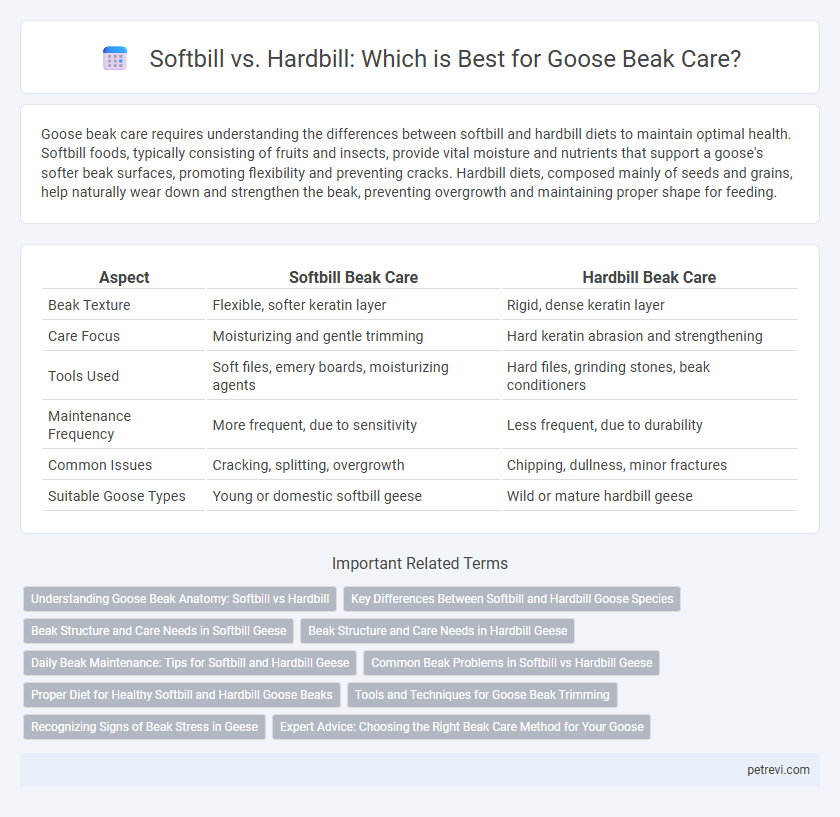Goose beak care requires understanding the differences between softbill and hardbill diets to maintain optimal health. Softbill foods, typically consisting of fruits and insects, provide vital moisture and nutrients that support a goose's softer beak surfaces, promoting flexibility and preventing cracks. Hardbill diets, composed mainly of seeds and grains, help naturally wear down and strengthen the beak, preventing overgrowth and maintaining proper shape for feeding.
Table of Comparison
| Aspect | Softbill Beak Care | Hardbill Beak Care |
|---|---|---|
| Beak Texture | Flexible, softer keratin layer | Rigid, dense keratin layer |
| Care Focus | Moisturizing and gentle trimming | Hard keratin abrasion and strengthening |
| Tools Used | Soft files, emery boards, moisturizing agents | Hard files, grinding stones, beak conditioners |
| Maintenance Frequency | More frequent, due to sensitivity | Less frequent, due to durability |
| Common Issues | Cracking, splitting, overgrowth | Chipping, dullness, minor fractures |
| Suitable Goose Types | Young or domestic softbill geese | Wild or mature hardbill geese |
Understanding Goose Beak Anatomy: Softbill vs Hardbill
Goose beak anatomy reveals distinct differences between softbill and hardbill types, affecting their care requirements. Softbill geese have more sensitive, flexible beaks with a thinner keratin layer, necessitating gentle maintenance to prevent damage. Hardbill geese possess thicker, more robust keratinized beaks suited for tougher foraging, requiring regular trimming to avoid overgrowth and ensure healthy function.
Key Differences Between Softbill and Hardbill Goose Species
Softbill goose species have softer, more flexible beaks adapted for grazing on grasses and soft vegetation, requiring gentle care to prevent damage or injury. Hardbill geese possess sturdier, thicker beaks designed for cracking seeds and tough plant material, necessitating specific maintenance to avoid overgrowth and ensure proper function. Key differences include beak texture, dietary habits influencing wear patterns, and tailored grooming practices essential for each species' health and feeding efficiency.
Beak Structure and Care Needs in Softbill Geese
Softbill geese possess a softer, more pliable beak structure compared to hardbill counterparts, demanding gentle care to prevent damage or wear. Their beaks, less keratinized and more sensitive, require regular moisturizing and careful trimming to maintain optimal health and functionality. Proper diet rich in essential nutrients supports natural beak strength and promotes self-maintenance behaviors crucial for softbill geese.
Beak Structure and Care Needs in Hardbill Geese
Hardbill geese possess robust, thick beaks adapted for cracking seeds and tough vegetation, requiring consistent wear to prevent overgrowth. Proper care involves providing abrasive surfaces or natural materials like gravel to ensure effective beak maintenance and natural shaping. In contrast to softbill species, whose softer beaks require gentler care, hardbill geese demand a diet and environment that support the durability and functionality of their strong beak structure.
Daily Beak Maintenance: Tips for Softbill and Hardbill Geese
Softbill and hardbill geese require tailored daily beak maintenance to prevent overgrowth and damage, with softbill species benefiting from softer grazing materials and regular gentle trimming, while hardbill geese need tougher browsing options and more frequent beak inspections. Providing mineral blocks and natural abrasives such as coarse grit enhances beak health by facilitating natural wear and strengthening keratin layers. Consistent monitoring ensures early detection of abnormalities, supporting optimal feeding efficiency and overall avian well-being.
Common Beak Problems in Softbill vs Hardbill Geese
Softbill geese often face overgrown and cracked beak problems due to their softer keratin composition, leading to feeding difficulties and increased infection risks. Hardbill geese typically experience fewer beak deformities but are prone to wear-related abrasions and chips because of the harder, more durable beak structure. Regular monitoring and proper environmental enrichment are essential to prevent common issues like beak splitting in softbills and excessive wear in hardbills.
Proper Diet for Healthy Softbill and Hardbill Goose Beaks
Proper diet plays a critical role in maintaining healthy softbill and hardbill goose beaks. Softbill geese benefit from diets rich in leafy greens, aquatic plants, and fruits that provide essential vitamins and moisture to keep beaks pliable and prevent cracking. Hardbill geese require a mineral-rich diet with access to grit and coarse grains to naturally wear down their tougher beaks and support optimal keratin growth.
Tools and Techniques for Goose Beak Trimming
Softbill beak care for geese requires gentle tools such as fine emery boards and specialized soft files to avoid damaging the sensitive keratin layer, promoting gradual wear and precise shaping. Hardbill trimming involves more robust instruments like heavy-duty nail clippers or rotary tools designed to handle tougher, thicker beak structures common in older or wild geese. Effective techniques emphasize controlled, incremental trimming to prevent overcutting and maintain proper beak alignment, ensuring the goose's ability to feed and preen naturally.
Recognizing Signs of Beak Stress in Geese
Softbill treats are easier on a goose's beak, reducing the risk of cracks and overgrowth common with hardbill diets. Signs of beak stress in geese include visible chips, abnormal wear patterns, and reluctance to eat, indicating potential discomfort or injury. Regular inspection and providing softbill options help maintain optimal beak health and prevent chronic issues in domesticated and wild geese populations.
Expert Advice: Choosing the Right Beak Care Method for Your Goose
Expert advice for goose beak care emphasizes the importance of selecting between softbill and hardbill methods based on the bird's natural behavior and beak condition. Softbill care, which involves gentle filing and moisturizing, suits goslings or geese with sensitive or damaged beaks, preventing injury and promoting healing. Hardbill care, employing controlled abrasion tools, is recommended for adult geese with robust beaks needing maintenance to avoid overgrowth and structural issues.
Softbill vs Hardbill for Goose beak care Infographic

 petrevi.com
petrevi.com